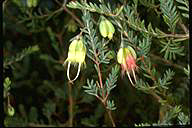

 |
Australian National Botanic Gardens |
 |
A weekly news sheet prepared by a Gardens' volunteer.
Numbers in square brackets [ ] refer to garden bed Sections.
Plants in flower are in bold type.
11 July 2008
 |
Homoranthus darwinioides- click for larger image |
This is a walk in the Rock Garden where flowers are many. Today almost 60 different flowers were listed and only about 22 can fit on this page so come and enjoy the beauty of these flowers. Commencing in front of the picturesque waterfall walking in a clockwise direction where the Gymea Lilies, Doryanthes excelsa [Section 15C] with large sward-like leaves and tall spikes tipped with large buds stand. In front the dwarf Leucopogon microphyllus [Section 15C] is massed with tiny white flowers amid the dark foliage. Banksia integrifolia subsp. integrifolia [Section 15C] is a semi-prostrate shrub having lemon flower spikes mingling with the silver backed leaves. Opposite, Banksia ‘Honeypots’ [Section 15D], supposedly a dwarf shrub with upright cylindrical flower spikes aptly named. Close by Grevillea speciosa subsp. dimorpha [Section 15D] is a many branched upright shrub with reddish spider flowers clinging to the branches.
In the opposite small garden Boronia coerulescens subsp.coerulescens [Section 15E] is a dwarf shrub with bluish coloured buds and tiny pink flowers. Beside is a tufted plant, Conostylis candicans [Section 15E] dense with strappy leaves and heads of bright yellow buds on upright stems. Homoranthus darwinioides [Section 15F] has a coverage of grey-blue foliage and unique cream flowers which redden on ageing. Hypocalymma xanthopetalum [Section 15F] is bright with small feathery flowers over the small shrub. Cascading down the slope, Grevillea lanigera [Section 15W] is a dense groundcover with an abundance of pink and cream spider flowers. Worth viewing, Micromyrtus ciliata [Section 115G] sitting above the rocks, is a small shrub with brick red buds which will mature to small white flowers.
Beside the stairs the grand old Grevillea ‘Masons Hybrid’ [Section 15H] has long weaving limbs terminating with a show of its large red and cream flower spikes. Opposite Homoranthus flavescens [Section 15A] is a low flat topped shrub with branches terminating with red or yellow buds. From the top road Thomasia petalocalyx [Section 15H] is prolific with pink down-turned flowers. Scaevola albida var. albida [Section 15H] has conspicuous white fan-shaped flowers on the low dense shrub while beside, is Dampiera sylvestris [Section 15H] is a suckering plant with blue flowers on upright stems. Cryptandra sp. [Section 15H] is a small shrub white with tiny flowers. Olearia astroloba [Section 15H] is medium and dense displaying its mauve daisies.
Taking the downward path between the grass trees, Xanthorrhoea johnsonii [Sections 15J,14] and opposite the large wattle, Acacia baileyana ‘Purpurea’ [Section 3] clad with its soft fluffy yellow flower balls, to Banksia ‘Birthday Candles’ [Section 15L] with an abundance of golden cylindrical flower spikes. Opposite, the Cauliflower Hakea, Hakea corymbosa [Section 15P] is a well manicured compact shrub with sharp narrow leaves all covered with pale yellow flowers. Behind Hakea obtusa [Section 15P] is a taller open shrub pretty with pink globular flower clusters attached to the woody branches.
Following the downward path glimpses of the bright starry flowers of Crowea ‘Festival’[Section 15S] can be seen mixed with other shrubs. Hardenbergia violacea ‘Mini Haha’ [Section 15S] is revealing the first of its deep purple pea flowers on its trailing stems and Thryptomene denticulata [Section 15S] is still as attractive with its coverage of tiny pink flowers along the arching branches. Then, in the garden in front of the waterfall are four emu bushes including Eremophila latrobei var. latrobei [Section 15V] … well come and enjoy them.